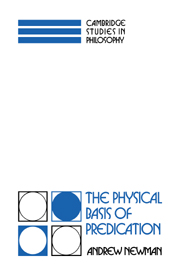Book contents
- Frontmatter
- Contents
- Acknowledgements
- Introduction
- Chapter 1 “Real constituents of the world”
- Chapter 2 What can logic and language tell us about reality?
- Chapter 3 The “existence” of universals and the notion of possibility
- Chapter 4 The causal significance of basic attributes
- Chapter 5 Hierarchies of universals
- Chapter 6 Causal relations
- Chapter 7 Arbitrary particulars and unified particulars
- Chapter 8 Further considerations concerning the causal relation
- Chapter 9 Arbitrary particulars and physical objects
- Bibliography
- Index
- Frontmatter
- Contents
- Acknowledgements
- Introduction
- Chapter 1 “Real constituents of the world”
- Chapter 2 What can logic and language tell us about reality?
- Chapter 3 The “existence” of universals and the notion of possibility
- Chapter 4 The causal significance of basic attributes
- Chapter 5 Hierarchies of universals
- Chapter 6 Causal relations
- Chapter 7 Arbitrary particulars and unified particulars
- Chapter 8 Further considerations concerning the causal relation
- Chapter 9 Arbitrary particulars and physical objects
- Bibliography
- Index
Summary
The aim of this book is to give an account of which things are the “real constituents of the world”. The account is based, to begin with, on a characterization of the notion of universal. It also attempts to decide which particulars are real constituents of the world, and in doing so argues against events, and things like events, in a number of different ways. The focus is on causality, particularly the notion of causal relation, as a guide to what is real.
The central theme is that the natural world is a world of particulars and universals as understood by immanent realism. In order to make that more precise, I argue that it is special sorts of universals – namely, basic universals – and special sorts of particulars – namely, unified particulars – which are the real constituents of the world. It is not part of my intention to show that immanent realism is the correct theory of universals, since there are other works that do that, notably Armstrong's. In the course of the discussion, however, arguments will be given that will show the superiority of that theory. The work should be regarded as being in the area of metaphysics or general ontology; epistemology and semantics will, on the whole, be avoided. My interest is in how things are, not in how we come to know how they are. I hope the conclusions can serve as metaphysical foundations for scientific realism, while avoiding attachment to any particular scientific theory.
- Type
- Chapter
- Information
- The Physical Basis of Predication , pp. ix - xiiPublisher: Cambridge University PressPrint publication year: 1992
- 4
- Cited by



